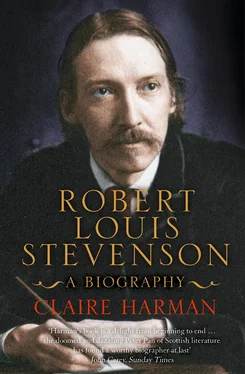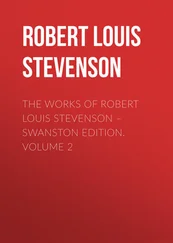Nevertheless, what Stevenson says of John Tod’s quintessentially Scots trait of ‘adorning’ his talk and making it startlingly vivid is egregiously true of Stevenson himself; ‘when he narrated, the scene was before you’. The irony is, of course, that Stevenson became known as a superlative English stylist because he was so alert to the power of his unknown native tongue. And as for the ‘romance and curiosity’ of Scotland, Stevenson’s version of it in novels such as Kidnapped, Catriona, The Master of Ballantrae and Weir of Hermiston did almost as much to promote and perpetuate the Scottish myth in the twentieth century as his great forerunner Walter Scott had done in the nineteenth.
In the autumn of 1867, the bullet had to be bitten and an engineering degree begun. The contrast between Lewis’s technical education at Edinburgh and Bob’s ‘semi-scenic life’ in Cambridge, with its gentlemanly atmosphere of ancient quadrangles and cultured conversation, could hardly have been stronger. As the bell rang them in to lectures from the city streets or pubs, all classes of raw Scots youth shuffled together on the ‘greasy benches’, as Stevenson recalled vividly in ‘The Foreigner at Home’:
The first muster of a college class in Scotland is a scene of curious and painful interest; so many lads, fresh from the heather, hang round the stove in cloddish embarrassment, ruffled by the presence of their smarter comrades, and afraid of the sound of their own rustic voices. 9
No proctors, privileges or grand ceremonials here. When the classes broke up, many of the students had to hurry home to get back to work in the fields in order to earn their next winter’s college fees. It must have been an eye-opener to Lewis, whose school life (such as it was) had been spent wholly among middle-class children, and though he approved of the ‘healthy democratic atmosphere’ of the university, and admired those of the staff who strove to put the parish boys at ease, he made no close friends among his fellow engineering students, indeed felt increasingly isolated and lonely.
Around this time (1868–69) Stevenson changed his name from Lewis to the Frenchified ‘Louis’. It is said that the impetus behind the change was Thomas Stevenson’s sudden and overpowering dislike of an Edinburgh radical and dissenter called David Lewis, who embodied, in the engineer’s view, ‘everything dangerous in Church and State’. 10 But as the pronunciation remained identical, Lewis – or Louis as we must now call him – may have intended it more as a joke than as a gesture of political solidarity, and it took a while to stick. * 1868 was also the year in which Thomas Stevenson published an essay in the Church of Scotland Home and Foreign Missionary Record (later produced as a pamphlet by Blackwood’s) on ‘The Immutable Laws of Nature in Relation to God’s Providence’. This short work is notable for several reasons: for its slightly simple-minded grappling with the evolutionary controversies of the day and for its ardent struggle to develop a response to them consistent with Church doctrine. The author argues, for example, that a falling stone falls from two causes, ‘first, proximately, in virtue of the law of gravitation; but second, primarily, by the supreme will of God, who has called the law of gravitation into existence’ (one can catch the author’s pleasure in coining that ‘second, primarily’). And if man ‘has been raised from the gorilla, as is hinted at by the new school of naturalists, how comes it to pass that the dog, although resembling man so little physically, should be so much more than the gorilla akin to him in all his nobler feelings and affections?’ The style of argument gives one an idea of what Louis was up against when he and his father began to discourse ardently at the dinner table on matters of religion and science, for the youth had been reading Darwin, and Herbert Spencer, whose works his father would never countenance. But there is another passage in Thomas’s booklet of even greater relevance, one which may well have come to haunt his son:
Men of literature and science may therefore well pause ere they lift their pen to write a word which tends to shake the faith of others [ … ] How terrible will it be to such an author, when toiling all alone through the dark valley of the shadow of death, should conscience remind him, when thus entering the dark portals of the tomb, of the pernicious legacy which he has left to mankind! 11
Publication fascinated the young student of engineering, who had secretly become fixated on the consumption and production of literature. ‘I had already my own private determination to be an author,’ he wrote in ‘The Education of an Engineer’. 12 But the acquisition of technique, that seemed to him all-important, was difficult. Three of the four stories in his juvenile ‘School Boys Magazine’ had ended on a cliffhanger with the words ‘To Be Continued’. The pleasure in writing the beginnings of stories (natural enough in an apprentice) and a revulsion from the work involved in finishing them would remain the most marked characteristics of Stevenson’s creative life.
To be continued … by whom? One solution to the problem was to share the burden with a collaborator. In the spring of 1868, while he was also trying to write his ‘covenanting novel’, Louis wrote to Bob, ‘Don’t you think you and I might collaborate a bit this summer. Something dramatic, blank verse and Swinburne choruses.’ 13 Just the idea of collaboration then set him off in the same letter on a long sketch of two possible plays, the second of which, a tragedy about the Duke of Monmouth, got so elaborate as to put off any potential helper from the start:
Scene, a palace chamber. Without famine and revolt and an enemy investing the plains. A. found making love to B. Enter Prince who overhears. P. and A. quarrel, P. being also in love with B. Swords are drawn but D., who resembles A. very closely separates them. Exit P., cursing and muttering
– and so forth. ‘Write me your opinion of the thing and I will write the first scene which nothing can alter. I’ll then send it to you for alteration, amendment and addition, and we can parcel out the rest of the thing or alter it,’ he wrote humorously, acknowledging how tenacious he was likely to be of all his own ideas. What he really wanted was not a co-author, but a goad – or at the very least an enthusiastic audience. No wonder Bob didn’t jump at the offer, and apart from friendly encouragement contributed nothing to ‘Monmouth: A Tragedy’. But the object was achieved: the play was one of the few projects of the scores started during his teens that Louis managed to complete.
In his demanding, self-imposed and self-policed apprenticeship, Louis tried on a dizzying variety of literary styles, as he recalled satirically many years later:
Cain , an epic, was (save the mark!) an imitation of Sordello : Robin Hood , a tale in verse, took an eclectic middle course among the fields of Keats, Chaucer and Morris: in Monmouth , a tragedy, I reclined on the bosom of Mr. Swinburne; in my innumerable gouty-footed lyrics, I followed many masters; in the first draft of The King’s Pardon , a tragedy, I was on the trail of no lesser man than John Webster; in the second draft of the same piece, with staggering versatility, I had shifted my allegiance to Congreve [ … ] Even at the age of thirteen I had tried to do justice to the inhabitants of the famous city of Peebles in the style of the Book of Snobs. 14
‘Nobody had ever such pains to learn a trade as I had; but I slogged at it, day in, day out; and I frankly believe (thanks to my dire industry) I have done more with smaller gifts than almost any man of letters in the world,’ Stevenson wrote modestly. 15 What he needed no time to learn, however, was what to write about: his subject was always, somehow, himself.
Читать дальше












